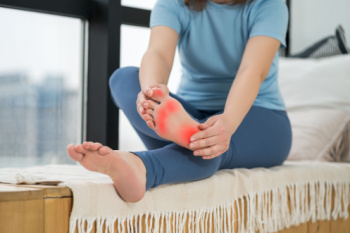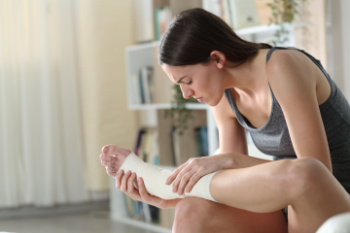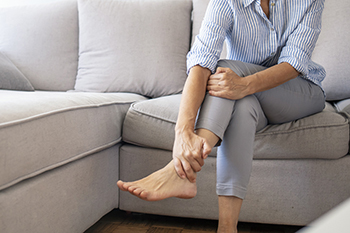Connect With Us
Blog
 Plantar heel pain, often referred to as plantar fasciitis, can cause discomfort and interfere with daily activities. It typically occurs when the band of tissue that supports the arch of the foot, called the plantar fascia, becomes irritated or inflamed. This condition often brings sharp pain in the heel, especially when taking the first steps in the morning or after prolonged periods of rest. Plantar heel pain can be triggered by various factors, including overuse, improper footwear, obesity, or certain foot structures. A podiatrist, or foot doctor, may recommend treatments such as stretching exercises, orthotic inserts, or in severe cases, corticosteroid injections and possibly surgery. With proper care and treatment, most people can find relief from plantar heel pain and get back to enjoying their daily activities without discomfort. If you are suffering from heel pain, it is suggested that you make an appointment with a podiatrist.
Plantar heel pain, often referred to as plantar fasciitis, can cause discomfort and interfere with daily activities. It typically occurs when the band of tissue that supports the arch of the foot, called the plantar fascia, becomes irritated or inflamed. This condition often brings sharp pain in the heel, especially when taking the first steps in the morning or after prolonged periods of rest. Plantar heel pain can be triggered by various factors, including overuse, improper footwear, obesity, or certain foot structures. A podiatrist, or foot doctor, may recommend treatments such as stretching exercises, orthotic inserts, or in severe cases, corticosteroid injections and possibly surgery. With proper care and treatment, most people can find relief from plantar heel pain and get back to enjoying their daily activities without discomfort. If you are suffering from heel pain, it is suggested that you make an appointment with a podiatrist.
Many people suffer from bouts of heel pain. For more information, contact Eugene Little, DPM of Foot and Ankle Centers of Ohio. Our doctor can provide the care you need to keep you pain-free and on your feet.
Causes of Heel Pain
Heel pain is often associated with plantar fasciitis. The plantar fascia is a band of tissues that extends along the bottom of the foot. A rip or tear in this ligament can cause inflammation of the tissue.
Achilles tendonitis is another cause of heel pain. Inflammation of the Achilles tendon will cause pain from fractures and muscle tearing. Lack of flexibility is also another symptom.
Heel spurs are another cause of pain. When the tissues of the plantar fascia undergo a great deal of stress, it can lead to ligament separation from the heel bone, causing heel spurs.
Why Might Heel Pain Occur?
- Wearing ill-fitting shoes
- Wearing non-supportive shoes
- Weight change
- Excessive running
Treatments
Heel pain should be treated as soon as possible for immediate results. Keeping your feet in a stress-free environment will help. If you suffer from Achilles tendonitis or plantar fasciitis, applying ice will reduce the swelling. Stretching before an exercise like running will help the muscles. Using all these tips will help make heel pain a condition of the past.
If you have any questions please contact our office located in Sidney, OH . We offer the newest diagnostic and treatment technologies for all your foot and ankle needs.

Stress fractures are common injuries to the bones of the legs and feet, resulting from repetitive stress rather than sudden injury. These hairline cracks in the bone affect athletes, including runners, basketball players, or dancers. Pain from stress fractures is particularly felt during weight-bearing activities and direct pressure on the bone. They may be difficult to diagnose as the pain often subsides when activity stops. Because they do not always show up on an X-ray, further diagnostic tests, like CT or MRI scans may be needed. Left untreated, stress fractures in the feet or ankles can worsen, leading to more severe complications. Seeking timely medical attention from a podiatrist is essential for proper diagnosis and treatment tailored to individual needs. This facilitates pain relief, promotes healing, and prevents further damage. If you are experiencing symptoms suggestive of a stress fracture, it is suggested that you schedule an appointment with a podiatrist.
Stress fractures occur when there is a tiny crack within a bone. To learn more, contact Eugene Little, DPM from Foot and Ankle Centers of Ohio. Our doctor can provide the care you need to keep you pain free and on your feet.
How Are They Caused?
Stress fractures are the result of repetitive force being placed on the bone. Since the lower leg and feet often carry most of the body’s weight, stress fractures are likely to occur in these areas. If you rush into a new exercise, you are more likely to develop a stress fracture since you are starting too much, too soon. Pain resulting from stress fractures may go unnoticed at first, however it may start to worsen over time.
Risk Factors
- Gender – They are more commonly found in women compared to men.
- Foot Problems – People with unusual arches in their feet are more likely to develop stress fractures.
- Certain Sports – Dancers, gymnasts, tennis players, runners, and basketball players are more likely to develop stress fractures.
- Lack of Nutrients – A lack of vitamin D and calcium may weaken the bones and make you more prone to stress fractures
- Weak Bones – Osteoporosis can weaken the bones therefore resulting in stress fractures
Stress fractures do not always heal properly, so it is important that you seek help from a podiatrist if you suspect you may have one. Ignoring your stress fracture may cause it to worsen, and you may develop chronic pain as well as additional fractures.
If you have any questions, please feel free to contact our office located in Sidney, OH . We offer the newest diagnostic and treatment technologies for all your foot care needs.
 Choosing the right shoes is important for people with arthritic feet. Wearing proper footwear can significantly alleviate pain and improve mobility, while the wrong shoes can worsen symptoms of arthritis. Shoes with a wide toe box, cushioned soles, and adequate arch support can help distribute weight evenly, reduce pressure on sensitive areas, and support the foot's natural shape. Additionally, shoes with adjustable closures, such as Velcro straps or laces, can accommodate changes in foot size due to swelling. Podiatrists play a key role in this selection process by evaluating your specific foot structure, identifying areas of concern, and recommending footwear that addresses your unique needs. Podiatrists may also suggest custom orthotics, which are personalized insoles that fit inside your shoe. If you suffer from arthritic feet, it is suggested that you consult a podiatrist when choosing shoes for maximum support and comfort.
Choosing the right shoes is important for people with arthritic feet. Wearing proper footwear can significantly alleviate pain and improve mobility, while the wrong shoes can worsen symptoms of arthritis. Shoes with a wide toe box, cushioned soles, and adequate arch support can help distribute weight evenly, reduce pressure on sensitive areas, and support the foot's natural shape. Additionally, shoes with adjustable closures, such as Velcro straps or laces, can accommodate changes in foot size due to swelling. Podiatrists play a key role in this selection process by evaluating your specific foot structure, identifying areas of concern, and recommending footwear that addresses your unique needs. Podiatrists may also suggest custom orthotics, which are personalized insoles that fit inside your shoe. If you suffer from arthritic feet, it is suggested that you consult a podiatrist when choosing shoes for maximum support and comfort.
Arthritis can be a difficult condition to live with. If you are seeking treatment, contact Eugene Little, DPM from Foot and Ankle Centers of Ohio. Our doctor can provide the care you need to keep you pain-free and on your feet.
Arthritic Foot Care
Arthritis is a joint disorder that involves the inflammation of different joints in your body, such as those in your feet. Arthritis is often caused by a degenerative joint disease and causes mild to severe pain in all affected areas. In addition to this, swelling and stiffness in the affected joints can also be a common symptom of arthritis.
In many cases, wearing ill-fitting shoes can worsen the effects and pain of arthritis. Wearing shoes that have a lower heel and extra room can help your feet feel more comfortable. In cases of rheumatoid arthritis, the arch in your foot may become problematic. Buying shoes with proper arch support that contour to your feet can help immensely.
Alleviating Arthritic Pain
- Exercises that stretch the foot can prevent further pain and injury and increase mobility
- Most of the pain can be alleviated with anti-inflammatory drugs, heat, and topical medications
- Massages can help temporarily alleviate pain.
It is best to see your doctor for the treatment that is right for your needs and symptoms. Conditions vary, and a podiatrist can help you determine the right method of care for your feet.
If you have any questions, please feel free to contact our office located in Sidney, OH . We offer the newest diagnostic tools and technology to treat your foot and ankle needs.

